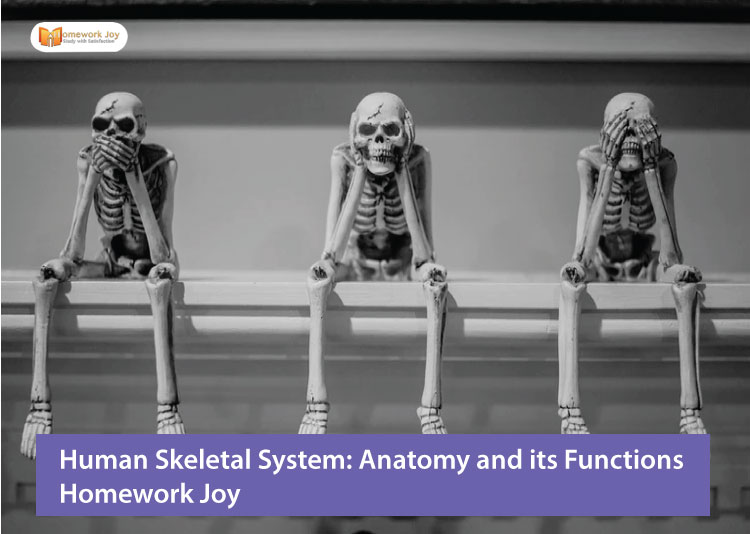Have you ever wondered what the human skeleton system consists of? The human skeletal system consists of bones, cartilage, and tendons, and human adults have 206 bones. On the contrary, children’s skeletons contain more bones since some of them, including those of the skull, fuse when they grow up. Also, you’ll be amazed to hear that human hands and feet contain over half of the body’s bones.
Besides, the human skeletal system performs three kinds of functions: support, protection and motion. Out of these functions, support is the most primitive and the oldest; similarly, the skeleton’s axial part was the first to evolve. Some of the functions of the human skeletal system are:
Firstly, the skull protects the brain, while the thoracic cage protects the heart and lungs.
Secondly, muscles attach to bones through tendons which allow the body to move in many different ways. Thirdly, the soft bone marrow inside many bones helps produce red blood cells, white blood cells, and platelets.
Also Read: Anatomy of Human Body System: A brief Overview | Homework Joy
What Are Human Bones Made Of?
If you’ve ever noticed a real skeleton in a museum, you might wonder that all bones are dead. However, bones in museums are dry and hard but the bones in the human body are different. The bones that make up the human skeleton system are growing and changing all the time.
The bones of the human skeletal system are made up of:
- The outer surface of the bone is the periosteum. It’s a thin, dense membrane consisting of nerves and blood vessels that nourish the bone.
- The following layer is compact bone. It is smooth but very hard.
- There are many layers of cancellous bone within the compact bone, which looks a bit like a sponge.
- The cancellous bone protects the innermost part of the bone, i.e, the bone marrow. Bone marrow is a thick jelly, and its function is to make blood cells.
Different Parts of the Human Skeletal System
The human skeletal system consists of two parts: The axial skeleton and the Appendicular skeleton.
Axial Skeleton System
The axial skeleton system consists of 80 bones. It comprises skull bones, auditory ossicles, hyoid, vertebral column, and thoracic cage.
Skull
The human skull comprises 22 bones. The skull bones can be further classified into:
Cranial bones: the cranial bone forms the bulk of the human skull, which further protects the human brain.
Facial bones: there are 14 facial bones in total, which makes up the front of the human skull and face.
Auditory ossicles
The auditory ossicles are the small bones located within the inner ear canal in the human skull. There are three auditory ossicles on each side of the head, making it total six in number. They are hammer,anvil and stirrup. The ossicles work together to transmit sound waves to the inner ear structures.
Hyoid
The hyoid is a U-shaped bone found at the base of the human jaw. It acts as a link between the muscles and ligaments in the neck.
Vertebral column
The vertebral column consists of 26 bones. The first 24 bones are all vertebrae, and the rest are sacrum and coccyx (tailbone).
Thoracic cage
The thoracic cage comprises the breastbone and 12 pairs of ribs. Hence, the bones form a protective cage around the heart and lungs.
Appendicular Skeleton System
The appendicular skeleton system consists of 126 bones. It includes the pectoral gilder, upper limbs, pelvic gilder, and lower limbs.
Pectoral gilder
It is a place where arms attach to the axial skeleton. The pectoral gilder have the collarbone and shoulder blade, one for each arm.
Upper limbs
Upper limbs consist of 30 bones in total. They are humerus, radius, ulna, carpals, metacarpals and phalanges.
Pelvic gilder
The pelvic girdle is commonly known as hips where legs attach to the axial skeleton. It consists of two hipbones, one for each leg.
Lower limbs
The lower limbs comprise 30 bones: femur, tibia, fibula, patella, tarsals, metatarsal and phalanges.
Conditions affecting the Skeletal System
The conditions which affect the skeletal system include fractures, arthritis, metabolic bone diseases, cancer, and spinal curvatures.
- Fractures are usually referred to as a broken bone. It occurs due to an injury or trauma, such as a car accident or a fall.
- Metabolic bone disease occurs when a group of conditions affects bone strength. It can be due to deficiency of vitamin D or loss of bone mass etc.
- Arthritis refers to inflammation of the joints, which can cause pain and a limited range of movement.
- Cancer can emerge in the tissues of the bone or the cells produced by bones.
- Spinal curvature is a disease where the spine doesn’t curve in its usual shape.
